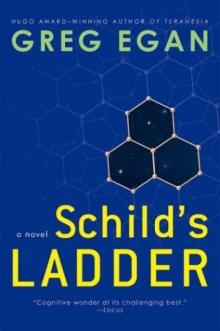Axiomatic Read online
Page 7
He shrugged. ‘Sick of the conditions here. Low pay, limited resources, bureaucratic restrictions, ethics committees. Some people learn to live with all that, some don’t.’
‘Would you know anything about her work, her particular research interests, after she left?’
‘I don’t know that she did much research. She seemed to have stopped publishing, so I really couldn’t say what she was up to.’
Shortly after that (with unusual speed), clearance came through to access her taxation records. Since ‘35 she had been self-employed as a ‘freelance biotechnology consultant’; whatever that meant, it had provided her with a seven-figure income for the past fifteen years. There were at least a hundred different company names listed by her as sources of revenue. I rang the first one and found myself talking to an answering machine. It was after seven. I rang St Dominic’s, and learnt that the chimera was still unconscious, but doing fine; the hormone mixture had arrived, and Muriel Beatty had located a veterinarian at the university with some relevant experience. So I swallowed my deprimers and went home.
* * *
The surest sign that I’m not fully down is the frustration I feel when opening my own front door. It’s too bland, too easy: inserting three keys and touching my thumb to the scanner. Nothing inside is going to be dangerous or challenging. The deprimers are meant to work in five minutes. Some nights it’s more like five hours.
Marion was watching TV, and called out, ‘Hi, Dan.’
I stood in the living room doorway. ‘Hi. How was your day?’ She works in a child-care centre, which is my idea of a high-stress occupation. She shrugged. ‘Ordinary. How was yours?’
Something on the TV screen caught my eye. I swore for about a minute, mostly cursing a certain communications officer who I knew was responsible, though I couldn’t have proved it. ‘How was my day? You’re looking at it.’ The TV was showing part of my helmet log; the basement, my discovery of the chimera.
Marion said, ‘Ah. I was going to ask if you knew who the cop was.’
‘And you know what I’ll be doing tomorrow? Trying to make sense of a few thousand phone calls from people who’ve seen this and decided they have something useful to say about it.’
‘That poor girl. Is she going to be OK?’
‘I think so.’
They played Muriel Beatty’s speculations, again from my point of view, then cut to a couple of pocket experts who debated the fine points of chimerism while an interviewer did his best to drag in spurious references to everything from Greek mythology to The Island of Doctor Moreau.
I said, ‘I’m starving. Let’s eat.’
* * *
I woke at half past one, shaking and whimpering. Marion was already awake, trying to calm me down. Lately I’d been suffering a lot from delayed reactions like this. A few months earlier, two nights after a particularly brutal assault case, I’d been distraught and incoherent for hours.
On duty, we are what’s called ‘primed’. A mixture of drugs heightens various physiological and emotional responses, and suppresses others. Sharpens our reflexes. Keeps us calm and rational. Supposedly improves our judgement. (The media like to say that the drugs make us more aggressive, but that’s garbage; why would the force intentionally create trigger-happy cops? Swift decisions and swift actions are the opposite of dumb brutality.)
Off duty, we are ‘deprimed’. That’s meant to make us the way we would be if we’d never taken the priming drugs. (A hazy concept, I have to admit. As if we’d never taken the priming drugs, and never spent the day at work? Or, as if we’d seen and done the very same things, without the primers to help us cope?)
Sometimes this seesaw works smoothly. Sometimes it fucks up.
I wanted to describe to Marion how I felt about the chimera. I wanted to talk about my fear and revulsion and pity and anger. All I could do was make unhappy noises. No words. She didn’t say anything, she just held me, her long fingers cool on the burning skin of my face and chest.
When I finally exhausted myself into something approaching peace, I managed to speak. I whispered,
‘Why do you stay with me? Why do you put up with this?’
She turned away from me and said, ‘I’m tired. Go to sleep.’
* * *
I enrolled for the force at the age of twelve. I continued my normal education, but that’s when you have to start the course of growth-factor injections, and weekend and vacation training, if you want to qualify for active duty. (It wasn’t an irreversible obligation; I could have chosen a different career later, and paid off what had been invested in me at a hundred dollars or so a week over the next thirty years. Or, I could have failed the psychological tests, and been dropped without owing a cent. But the tests before you even begin tend to weed out anyone who’s likely to do either.) It makes sense; rather than limiting recruitment to men and women meeting certain physical criteria, candidates are chosen according to intelligence and attitude, and then the secondary, but useful, characteristics of size, strength and agility are provided artificially.
So we’re freaks, constructed and conditioned to meet the demands of the job. Less so than soldiers or professional athletes. Far less so than the average street gang member, who thinks nothing of using illegal growth promoters that lower his life expectancy to around thirty years. Who, unarmed but on a mixture of Berserker and Timewarp (oblivious to pain and most physical trauma and with a twenty-fold decrease in reaction times), can kill a hundred people in a crowd in five minutes, then vanish to a safe house before the high ends and the fortnight of side effects begins. (A certain politician, a very popular man, advocates undercover operations to sell supplies of these drugs laced with fatal impurities, but he’s not yet succeeded in making that legal.)
Yes, we’re freaks; but if we have a problem, it’s that we’re still far too human.
* * *
When over a hundred thousand people phone in about an investigation, there’s only one way to deal with their calls. It’s called ARIA: Automated Remote Informant Analysis.
An initial filtering process identifies the blatantly obvious pranksters and lunatics. It’s always possible that someone who phones in and spends ninety per cent of his time ranting about UFOs, or communist conspiracies, or slicing up our genitals with razor blades, has something relevant and truthful to mention in passing, but it seems reasonable to give his evidence less weight than that of someone who sticks to the point. More sophisticated analysis of gestures (about thirty per cent of callers don’t switch off the vision), and speech patterns, supposedly picks up anyone who is, although superficially rational and apposite, actually suffering from psychotic delusions or fixations. Ultimately, each caller is given a ‘reliability factor’ between zero and one, with the benefit of the doubt going to anyone who betrays no recognisable signs of dishonesty or mental illness. Some days I’m impressed with the sophistication of the software that makes these assessments. Other days I curse it as a heap of useless voodoo.
The relevant assertions (broadly defined) of each caller are extracted, and a frequency table is created, giving a count of the number of callers making each assertion, and their average reliability factor. Unfortunately, there are no simple rules to determine which assertions are most likely to be true. One thousand people might earnestly repeat a widespread but totally baseless rumour. A single honest witness might be distraught, or chemically screwed up, and be given an unfairly poor rating. Basically, you have to read all the assertions—which is tedious, but still several thousand times faster than viewing every call.
(If desperate, I could view, one by one, the seventeen hundred and thirty-three calls of items 14 and 15. Not yet, though; I still had plenty of better ways to spend my time.)
That was hardly surprising, considering the number of paintings there must be of fantastic and mythical creatures. But on the next page:
Curious, I displayed some of the calls. The first few told me little more than the print-out’s summary line. Then, one m
an held up an open book to the lens. The glare of a light blub reflected off the glossy paper rendered parts of it almost invisible, and the whole thing was slightly out of focus, but what I could see was intriguing.
A leopard with a woman’s head was crouched near the edge of a raised, flat surface. A slender young man, bare to the waist, stood on the lower ground, leaning sideways on to the raised surface, cheek to cheek with the leopard woman, who pressed one forepaw against his abdomen in an awkward embrace. The man coolly gazed straight ahead, his mouth set primly, giving an impression of effete detachment. The woman’s eyes were closed, or nearly so, and her expression seemed less certain the longer I stared—it might have been placid, dreamy contentment, it might have been erotic bliss. Both had auburn hair.
I selected a rectangle around the woman’s face, enlarged it to fill the screen, then applied a smoothing option to make the blown-up pixels less distracting. With the glare, the poor focus, and limited resolution, the image was a mess. The best I could say was that the face in the painting was not wildly dissimilar to that of the woman I’d found in the basement.
A few dozen calls later, though, no doubt remained. One caller had even taken the trouble to capture a frame from the news broadcast and patch it into her call, side by side with a well-lit close-up of her copy of the painting. One view of a single expression does not define a human face, but the resemblance was far too close to be coincidental. Since—as many people told me, and I later checked for myself—The Caress had been painted in 1896 by the Belgian Symbolist artist Fernand Khnopff, the painting could not possibly have been based on the living chimera. So, it had to be the other way around.
I played all ninety-four calls. Most contained nothing but the same handful of simple facts about the painting. One went a little further.
A middle-aged man introduced himself as John Aldrich, art dealer and amateur art historian. After pointing out the resemblance, and talking briefly about Khnopff and The Caress, he added:
‘Given that this poor woman looks exactly like Khnopff’s sphinx, I wonder if you’ve considered the possibility that proponents of Lindhquistism are involved?’ He blushed slightly. ‘Perhaps that’s farfetched, but I thought I should mention it.’
So I called an on-line Britannica, and said, ‘Lindhquistism.’
Andreas Lindhquist, 1961-2030, was a Swiss performance artist, with the distinct financial advantage of being heir to a massive pharmaceuticals empire. Up until 2011, he engaged in a wide variety of activities of a bioartistic nature, progressing from generating sounds and images by computer processing of physiological signals (ECG, EEG, skin conductivity, hormonal levels continuously monitored by immunoelectric probes), to subjecting himself to surgery in a sterile, transparent cocoon in the middle of a packed auditorium, once to have his corneas gratuitously exchanged, left for right, and a second time to have them swapped back (he publicised a more ambitious version, in which he claimed every organ in his torso would be removed and reinserted facing backwards, but was unable to find a team of surgeons who considered this anatomically plausible).
In 2011, he developed a new obsession. He projected slides of classical paintings in which the figures had been blacked out, and had models in appropriate costumes and make-up strike poses in front of the screen, filling in the gaps.
Why? In his own words (or perhaps a translation):
The great artists are afforded glimpses into a separate, transcendental, timeless world. Does that world exist? Can we travel to it? No! We must force it into being around us! We must take these fragmentary glimpses and make them solid and tangible, make them live and breathe and walk amongst us, we must import art into reality, and by doing so transform our world into the world of the artists’ vision.
I wondered what ARIA would have made of that.
Over the next ten years, he moved away from projected slides. He began hiring movie set designers and landscape architects to recreate in three dimensions the backgrounds of the paintings he chose. He discarded the use of make-up to alter the appearance of models, and, when he found it impossible to obtain perfect lookalikes, he employed only those who, for sufficient payment, were willing to undergo cosmetic surgery.
His interest in biology hadn’t entirely vanished; in 2021, on his sixtieth birthday, he had two tubes implanted in his skull, allowing him to constantly monitor, and alter, the precise neurochemical content of his brain ventricular fluid. After this, his requirements became even more stringent. The ‘cheating’ techniques of movie sets were forbidden—a house, or a church, or a lake, or a mountain, glimpsed in the corner of the painting being ‘realised’, had to be there, full-scale and complete in every detail. Houses, churches and small lakes were created; mountains he had to seek out—though he did transplant or destroy thousands of hectares of vegetation to alter their colour and texture. His models were required to spend months before and after the ‘realisation’, scrupulously ‘living their roles’, following complex rules and scenarios that Lindhquist devised, based on his interpretation of the painting’s ‘characters’. This aspect grew increasingly important to him:
The precise realisation of the appearance—the surface, I call it, however three-dimensional—is only the most rudimentary beginning. It is the network of relationships between the subjects, and between the subjects and their setting, that constitutes the challenge for the generation that follows me.
At first, it struck me as astonishing that I’d never even heard of this maniac; his sheer extravagance must have earned him a certain notoriety. But there are millions of eccentrics in the world, and thousands of extremely wealthy ones—and I was only five when Lindhquist died of a heart attack in 2030, leaving his fortune to a nine-year-old son.
As for disciples, Britannica listed half a dozen scattered around Eastern Europe, where apparently he’d found the most respect. All seemed to have completely abandoned his excesses, offering volumes of aesthetic theories in support of the use of painted plywood and mime artists in stylised masks. In fact, most did just that—offered the volumes, and didn’t even bother with the plywood and the mime artists. I couldn’t imagine any of them having either the money or the inclination to sponsor embryological research thousands of kilometres away.
For obscure reasons of copyright law, works of visual art are rarely present in publicly accessible databases, so in my lunch hour I went out and bought a book on Symbolist painters which included a colour plate of The Caress. I made a dozen (illegal) copies, blow-ups of various sizes. Curiously, in each one the expression of the sphinx (as Aldrich had called her) struck me as subtly different. Her mouth and her eyes (one fully closed, one infinitesimally open) could not be said to portray a definite smile, but the shading of the cheeks hinted at one—in certain enlargements, viewed from certain angles. The young man’s face also changed, from vaguely troubled to slightly bored, from resolved to dissipated, from noble to effeminate. The features of both seemed to lie on complicated and uncertain borders between regions of definite mood, and the slightest shift in viewing conditions was enough to force a complete reinterpretation. If that had been Khnopff s intention it was a masterful achievement, but I also found it extremely frustrating. The book’s brief commentary was no help, praising the painting’s ‘perfectly balanced composition and delightful thematic ambiguity’, and suggesting that the leopard’s head was ‘perversely modelled on the artist’s sister, with whose beauty he was constantly obsessed’.
Unsure for the moment just how, if at all, I ought to pursue this strand of the investigation, I sat at my desk for several minutes, wondering (but not inclined to check) if every one of the leopard’s spots shown in the painting had been reproduced faithfully in vivo. I wanted to do something tangible, set something in motion, before I put The Caress aside and returned to more routine lines of inquiry.
So I made one more blow-up of the painting, this time using the copier’s editing facilities to surround the man’s head and shoulders with a uniform dark background. I t
ook it down to communications, and handed it to Steve Birbeck (the man I knew had leaked my helmet log to the media).
I said, ‘Put out an alert on this guy. Wanted for questioning in connection with the Macklenburg murder.’
* * *
I found nothing else of interest in the ARIA print-out, so I picked up where I’d left off the night before, phoning companies that had made use of Freda Macklenburg’s services.
The work she had done had no specific connection with embryology. Her advice and assistance seemed to have been sought for a wide range of unconnected problems in a dozen fields—tissue culture work, the use of retroviruses as gene-therapy vectors, cell membrane electrochemistry, protein purification, and still other areas where the vocabulary meant nothing to me at all.
‘And did Dr Macklenburg solve this problem?’
‘Absolutely. She knew a perfect way around the stumbling block that had been holding us up for months.’
‘How did you find out about her?’
‘There’s a register of consultants, indexed by speciality.’
There was indeed. She was in it in fifty-nine places. Either she somehow knew the detailed specifics of all these areas, better than many people who were actually working in them full-time, or she had access to world-class experts who could put the right words into her mouth.
Her sponsor’s method of funding her work? Paying her not in money, but in expertise she could then sell as her own? Who would have so many biological scientists on tap?
The Lindhquist empire?
(So much for escaping The Caress.)
Her phone bills showed no long-distance calls, but that meant nothing; the local Lindhquist branch would have had its own private international network.
I looked up Lindhquist’s son Gustave in Who’s Who. It was a very sketchy entry. Born to a surrogate mother. Donor ovum anonymous. Educated by tutors. As yet unmarried at twenty-nine. Reclusive. Apparently immersed in his business concerns. Not a word about artistic pretentions, but nobody tells everything to Who’s Who.

 Zendegi
Zendegi Permutation City
Permutation City The Eternal Flame
The Eternal Flame Artifacts
Artifacts Wang's Carpets
Wang's Carpets Dichronauts
Dichronauts Incandescence
Incandescence Teranesia
Teranesia Schild's Ladder
Schild's Ladder Quarantine
Quarantine The Four Thousand, the Eight Hundred
The Four Thousand, the Eight Hundred The Clockwork Rocket
The Clockwork Rocket Zeitgeber
Zeitgeber Phoresis
Phoresis The Nearest
The Nearest Diaspora
Diaspora Instantiation
Instantiation Distress
Distress An Unusual Angle
An Unusual Angle Oceanic
Oceanic The Arrows of Time
The Arrows of Time Axiomatic
Axiomatic![Anthology 2. Luminous [1998, 2010] Read online](http://i1.bookreadfree.com/i/03/18/anthology_2_luminous_1998_2010_preview.jpg) Anthology 2. Luminous [1998, 2010]
Anthology 2. Luminous [1998, 2010] Perihelion Summer
Perihelion Summer Luminous
Luminous